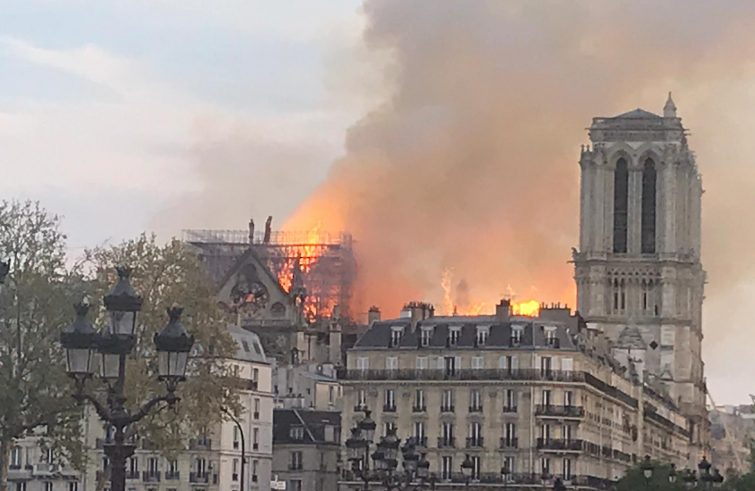
The fact that the fire of Notre Dame dramatically marks the centenary of the publication of a collection of essays by French book publisher Gaston Gallimard titled by its author Marcel Proust “En mémoire des églises assassinées”, along the same lines as a funeral eulogy, comes as a shock. The French writer shed bitter tears on the precious religious edifices destroyed by bombs during the First World War in historical cities like Amiens e Rouen. Among those writings figures an ancient text, dating back to 1904, whose content – and whose title: “La mort des cathédrales” – conveyed strong perplexities on some aspects of the Law whereby in July 1905 the Lower Chamber established the principle of laicitè and the separation (that may be also defined a contraposition) between the State and the Church in France.
That law risked blemishing the self-defining identity of the French people, or exposing it to misinterpretation, thereby making French citizens perceive themselves as foreigners in their homeland, yet prone to come running at the sudden toll of the bells of Notre Dame, but alas, reduced to a crowd of curious tourists today, in whose bosom “no longer dwelt the soul of a bygone era.”
Proust admitted it in times long gone by: overwhelmed – albeit not abated – in the late 18th century, when the revolutionaries ravaged the Parisian cathedral, devastating its interiors and destroying the statues on its portals and façade. Henri de Saint-Simon would have gladly purchased the ruins so as to raze them to the ground, if some other philosopher of the guillotine had not proposed to use it as a temple of the Goddess Reason. Victor Hugo voiced his lament in 1831, between the lines of his “Notre-Dame de Paris”.
Moreover, the dawn of the laicization process that was the object of Proust’s reflection, ascribing the most problematic aspects to the death of cathedrals, i.e. to their widespread loss of significance and meaning, is not only due to the myth of rationalism, whose implausibility, typical of all ideologies, was evident since its inception.
In fact – by paradox – it germinated in the alliance of the throne with the altar, which Napoleon Bonaparte restored –for his own advantage – in order to be crowned as Emperor at Notre-Dame in 1804. Secularization is a process that develops within the ecclesial world. And the laicization of society, in all its public spheres – from the cultural to the political sectors, from schools to town councils, from universities to parliaments, proceeds at the same pace as the ecclesial tendency to govern the spiritual life of believers with criteria and styles comparable to those employed to administer any other heritage, whether “material” or “immaterial”. To the point of giving equal dignity to a museum and a cathedral, or transforming a convent in a hotel.
Would Proust have been surprised at the sight of large numbers of youths passionately praying and singing in front of the Notre Dame Cathedral ravaged by the flames? Would he have thought that his predictions had been far too pessimistic, noting that mobile phones were safely placed in closed pockets in order to leave the hands free to be conjoined in an unexpected orating composure?
Or would he have dismissed those people as “conservative Catholics”, endorsing the comment expressed during RAI National Television broadcast by a French journalist, evidently prone to generalize in an attempt to tar everything with the same brush? Would the words of President Macron, representative and guarantor of the laicity of his nation, uttered with a broken voice, stating that Notre Dame – painfully set ablaze – remains the “Cathedral of all French people”, have finally sealed the resilient identity and culture of the great religious symbols? Would he have supported the view of Tomaso Montanari, our art historian, who in a in live recording noted that what has happened in Paris is a “human disaster” that inflicts a wound on us all, precisely as human beings, capable of preserving memory, yearning for beauty, aware that even stones convey the spirit of those who carved them?
For sure, the author that spent a long time “in search of lost time”, as titled his masterpiece, would have written another masterful, provocative text today.
Perhaps he might have consulted with the intellectuals in his home Country that are equally disenchanted as Proust who – as François Jullien, author of a recently-published pamphlet significantly titled: “Resources of Christianity” – once again wonder if secular Europe has something to gain by discarding the Gospel message in the waste-bin. Or he might have shared the opinion of Joseph Ratzinger, that with ill-concealed disarm a few days ago overturned the ecclesiological optimism of Romano Guardini – his ideal teacher, who in 1922 perceived an “ecclesial reawakening in human souls” – reiterating that if anything, “the Church dies in the souls.”
Who is right? Perhaps the right answer is to be found in the ashes of Notre Dame: a sorrowful form of divination that may serve to transform what some see as a macabre omen into renewed hope, to realize that the scenario requiring investigation is not the burned cathedral but the people all around it : is post-Christianity giving way to post-laïcité precisely in France?










